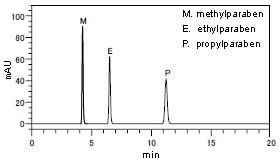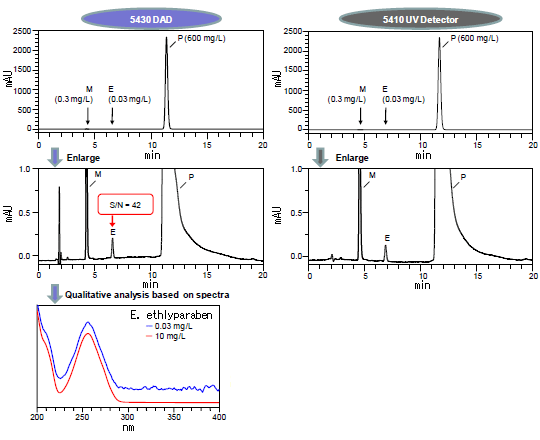Simultaneous Analysis of Main and Trace Components by High-sensitivity DAD
In the pharmaceutical field, the contents of any impurities in the drug substance or that in the drug product exceed 0.03 - 0.05% of the daily dosage (as the drug substance) need to be reported at the time of the application for a drug containing a new activ e ingredient. In the environmental field, the demand for the high-sensitivity analysis of trace residual substances is also on the increase.
The detector perform ance is an important factor to meet the requirement for this type of analysis. "Chromaster" 5430DAD, a li quid chromatography of Hitachi High-Tech, realizes the low noise and low drift levels equivalent to those of UV detectors and allows high-sensitivity analyses.
A simultaneous analysis of components contained at high and trace concentration levels by using parabens as the model samples is introduced here. Propylparaben (600 mg/L) and ethylparaben (0.03 mg/L) were analyzed at the same time. The concentration ratio of the two components was (10,000 : 0.5) and thus, the analysis model shown here is for the detection of a trace compone nt contained at 0.005% of the concentration of the main component.
Analysis Example of Three Parabens (10 mg/L each)

Analytical Conditions
| Column | HITACHI LaChrom C18(5µm) (4.6 mm I.D. x 150 mm) |
|---|---|
| Elluent | Water/Acetonitrile = 65/35 (v/v) |
| Flow rate | 1.0 mL/min |
| Column temperature | 40°C |
| Detection wavelength | DAD 254 nm, UV 254 nm |
| Injection vol. | 10 µL |
Analysis Examples for Three Parabens (Comparison Between DAD and UV Detector)

- Both 5430 DAD and 5410 UV detector showed a good linearity for propylparaben (0 - 600 mg/L) with the contribution ratio of 0.9992 and 0.9998, respectively.
- DAD realized the low noise level equivalent to that of UV detectors. As a result, the S/N =42 was obtained for ethylparaben (0.03 mg/L) by DAD, indicating that the trace components (0.005%) and main component can be sufficiently assayed simultaneously.
- By comparing the spectra, the qualitative analysis for ethylparaben was also possible.
(As the analysis was performed by serially connecting the detectors in order of DAD-UV, the peak obtained by the UV detector is slightly low and broad.)
NOTE:
These data are an example of measurement; the individual values cannot be guaranteed.
The system is for research use only, and is not intended for any animal or human therapeutic or diagnostic use.
In order to read a PDF file, you need to have Adobe® Reader®
